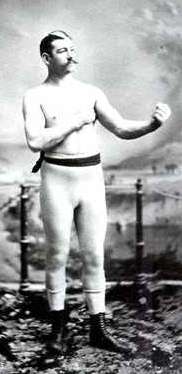Bare-knuckle boxing
 Irish American bare-knuckle boxer John L. Sullivan | |
| Also known as | Fisticuffs, Prizefighting |
|---|---|
| Focus | Striking |
| Country of origin | England |
| Creator | Unknown |
| Parenthood | Ancient Greek boxing, Street fighting |
Bare-knuckle boxing (also known as bare-knuckle, prizefighting, fist fight or fisticuffs) is the original form of boxing, closely related to ancient combat sports. It involves two individuals fighting without boxing gloves or other padding on their hands.
The difference between a streetfight and a bare-knuckle boxing match is an accepted set of rules, such as not striking a downed opponent.
Early history
The first bare-knuckle champion of England was James Figg, who claimed the title in 1719 and held it until his retirement in 1730. Other noted champions were Jack Broughton, Daniel Mendoza, Jem Belcher, Hen Pearce, John Gully, Tom Cribb, Tom Spring, Jem Ward, James Burke, William "Bendigo" Thompson, Ben Caunt, Tom Sayers and Jem Mace.[1]
The record for the longest bare-knuckle fight is listed as 6 hours and 15 minutes for a match between James Kelly and Jonathan Smith, fought near Fiery Creek, Victoria, Australia, on December 3, 1855, when Smith gave in after 17 rounds.[2]
The bare-knuckle fighter Jem Mace is listed as having the longest professional career of any fighter in history.[3] He fought for more than 35 years into his 60s,[4] and recorded his last exhibition bout in 1909 at the age of 79.
On 5 August 2011, the first sanctioned bout in the United States since 1889 took place at Fort McDowell Casino in Arizona between Rich Stewart of New Castle, Delaware and Bobby Gunn, with Gunn emerging as the victor.[5] The last sanctioned fight in 1889 was between John L. Sullivan and Jake Kilrain, with Sullivan emerging as the victor.[6]
Techniques
While boxing has always included punching, historically it also included grappling techniques like throws, arm locks, chokes as well as kicks. These techniques were banned during the several rule changes which turned classical pugilism, or bare knuckle boxing, into the modern sport of boxing.[7]
Irish stand down
"Irish stand down" is a type of traditional bare knuckle fighting where the aspect of maneuvering around the ring is removed, leaving only the less nuanced aspects of punching and "taking" punches. This form of combat was popular in Irish American ghettos in the United States in the late 19th century but was eclipsed in the Irish American community first by bare knuckle boxing and then later by regulation boxing. The Irish stand down is also known as strap fighting or toe to toe.
Modern bare knuckle boxing
Professional bouts are now held, created and managed by the World Bareknuckle Boxing Association which itself is not recognized as a sports organization anywhere outside of the United States. Any tournaments are illegal and/or unregulated in most countries today . However, in the British Isles where the sports are still very popular there are efforts for the sport to be brought out of the underground and into the mainstream.[8]
See also
- List of bare-knuckle boxers
- List of bare-knuckle lightweight champions
- London Prize Ring rules
- Russian fist fighting
References
- ↑ The Bare Knuckle Champions of England, retrieved 17 April 2009
- ↑ "The Victoria Ring", Bell's Life in Sydney and Sporting Reviewer, 22 December 1855
- ↑ "Synonyms Thesaurus With Definitions and Antonyms". trivia-library.com.
- ↑ James B. Roberts, Alexander G. Skutt, The Boxing Register: International Boxing Hall of Fame Official Record Book
- ↑ Woods, Michael (August 17, 2011). "Reviving a bygone, bare-knuckle era". ESPN. Retrieved June 17, 2015.
- ↑ Mastro, Tim (13 August 2011), "Fistful of Danger", The News Journal
- ↑ Lawson, Kirk (3 June 2011). Banned from Boxing - The forgotten grappling techniques of Classic Pugilism. lulu.com. ISBN 9781257140244.
- ↑ "Bare Knuckle". VICE.
- The Outsiders – Exposing the Secretive World of Ireland's Travellers Chapters 4 and 5 (ISBN 978-1-903582-67-1) by Eamon Dillon, published Nov 2006 by Merlin Publishing
Additional reading
David Snowdon, Writing the Prizefight: Pierce Egan's Boxiana World (2013)
External links
| ||||||||||||||||||||||||||||||